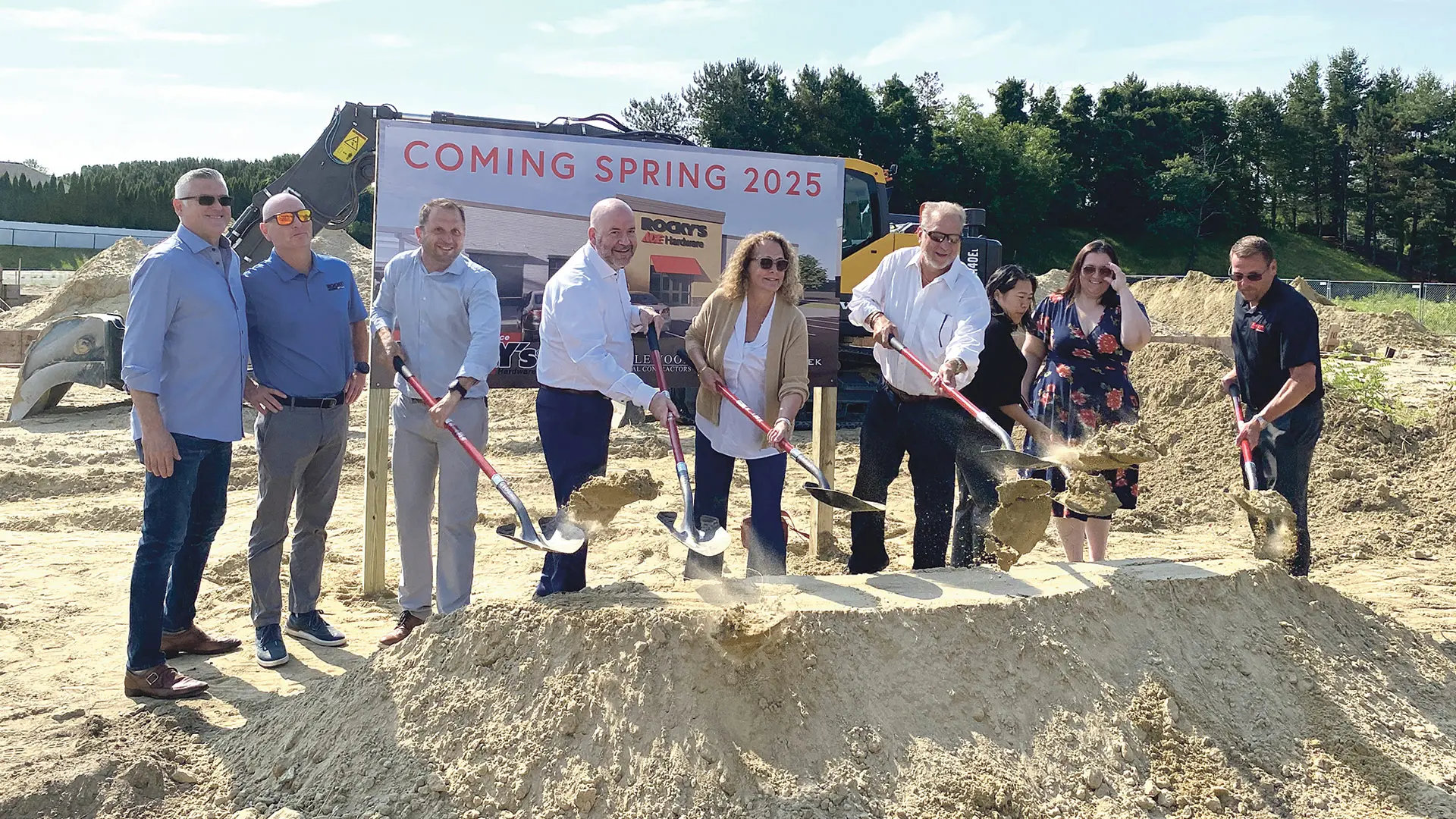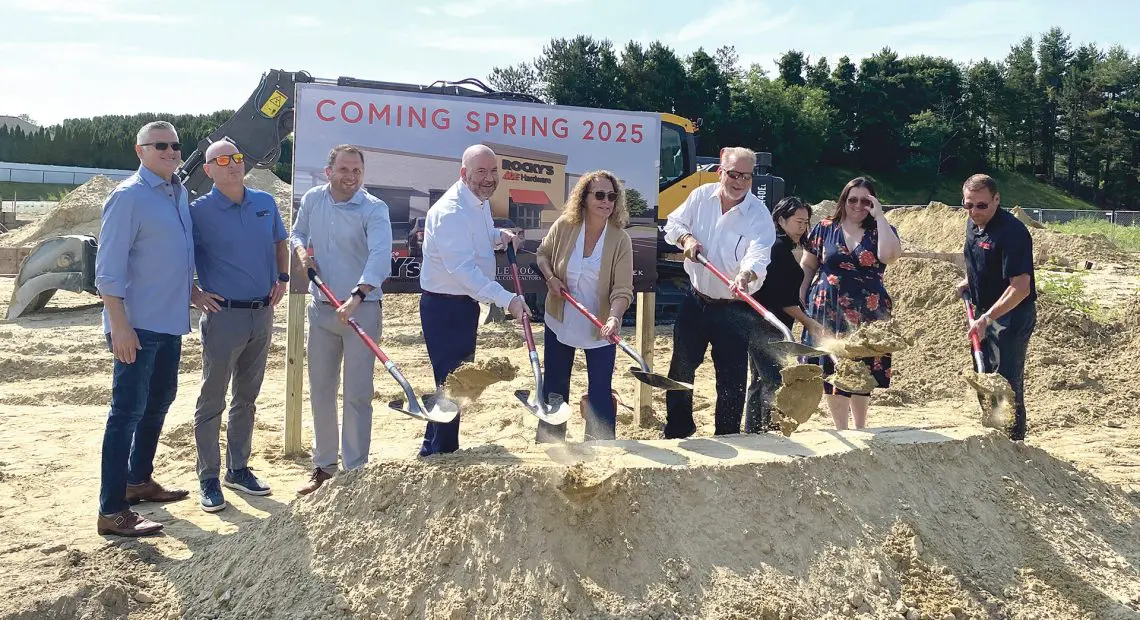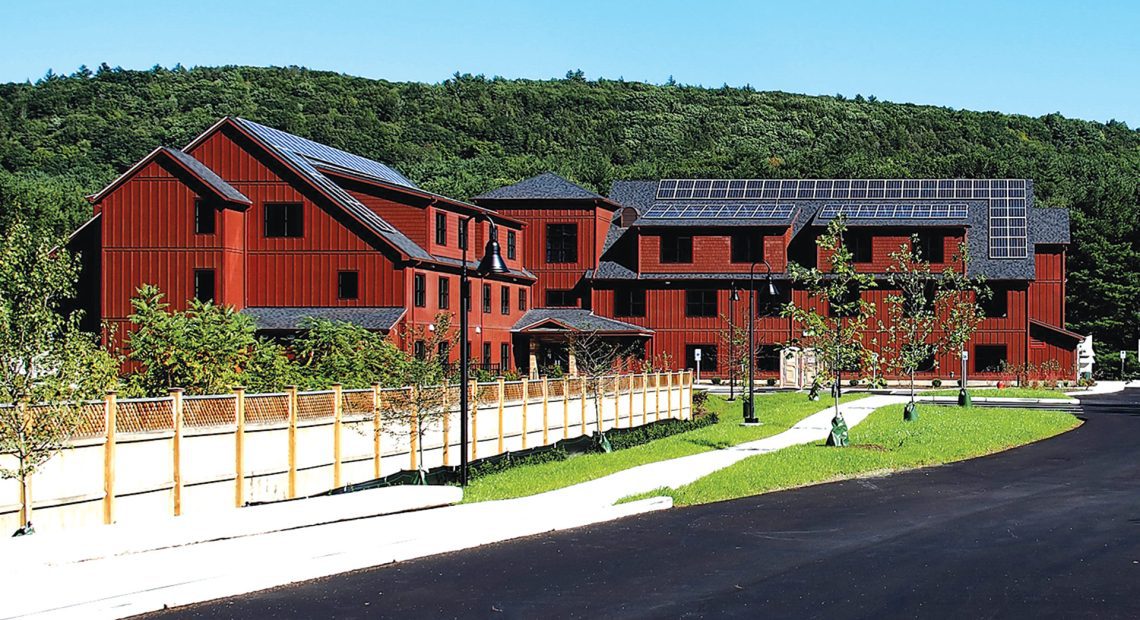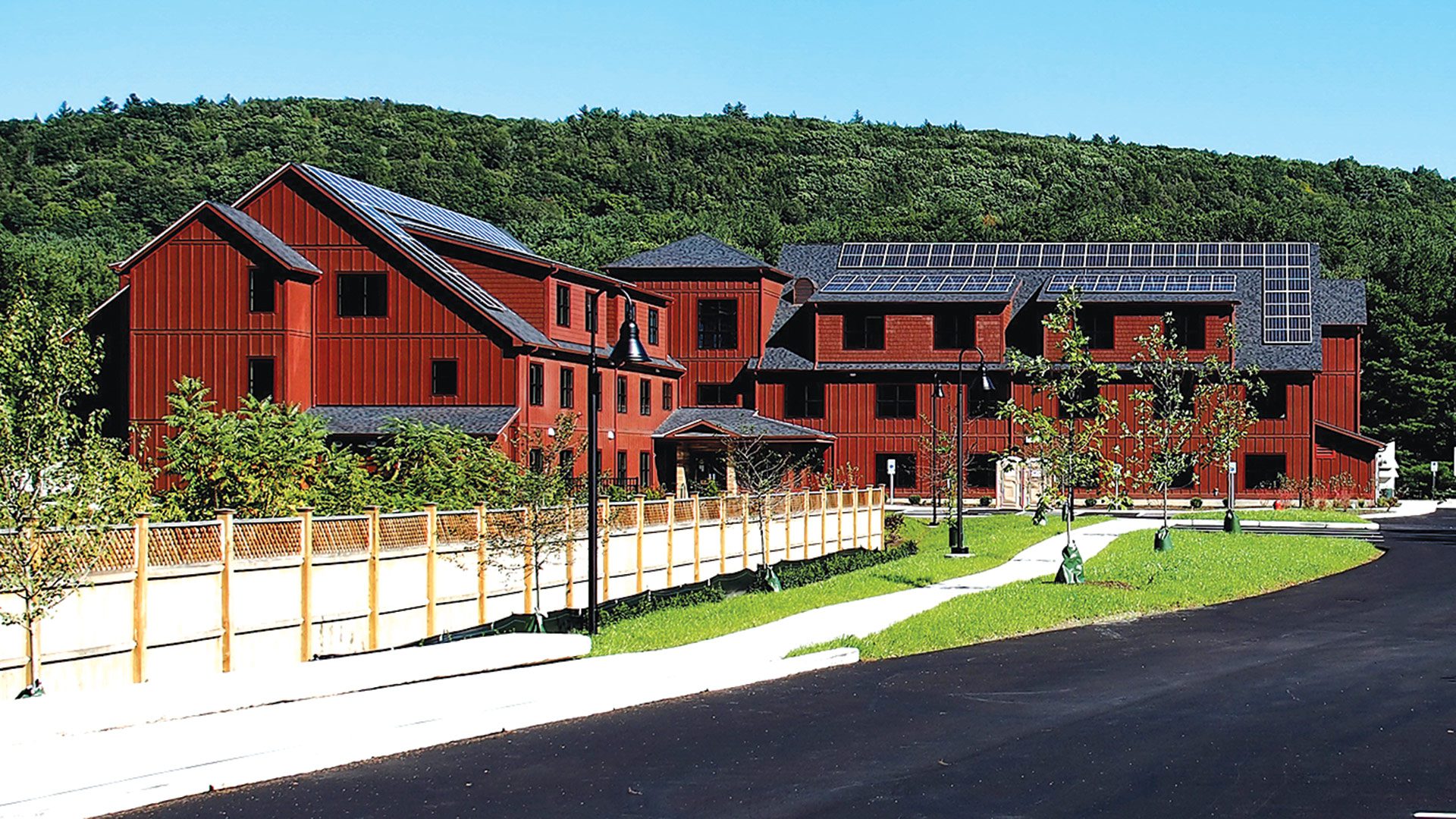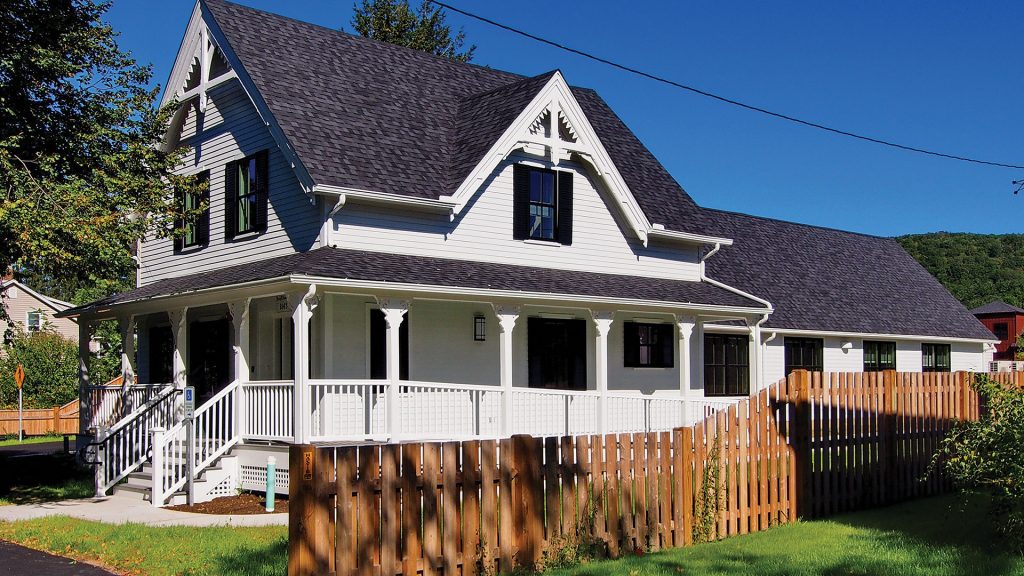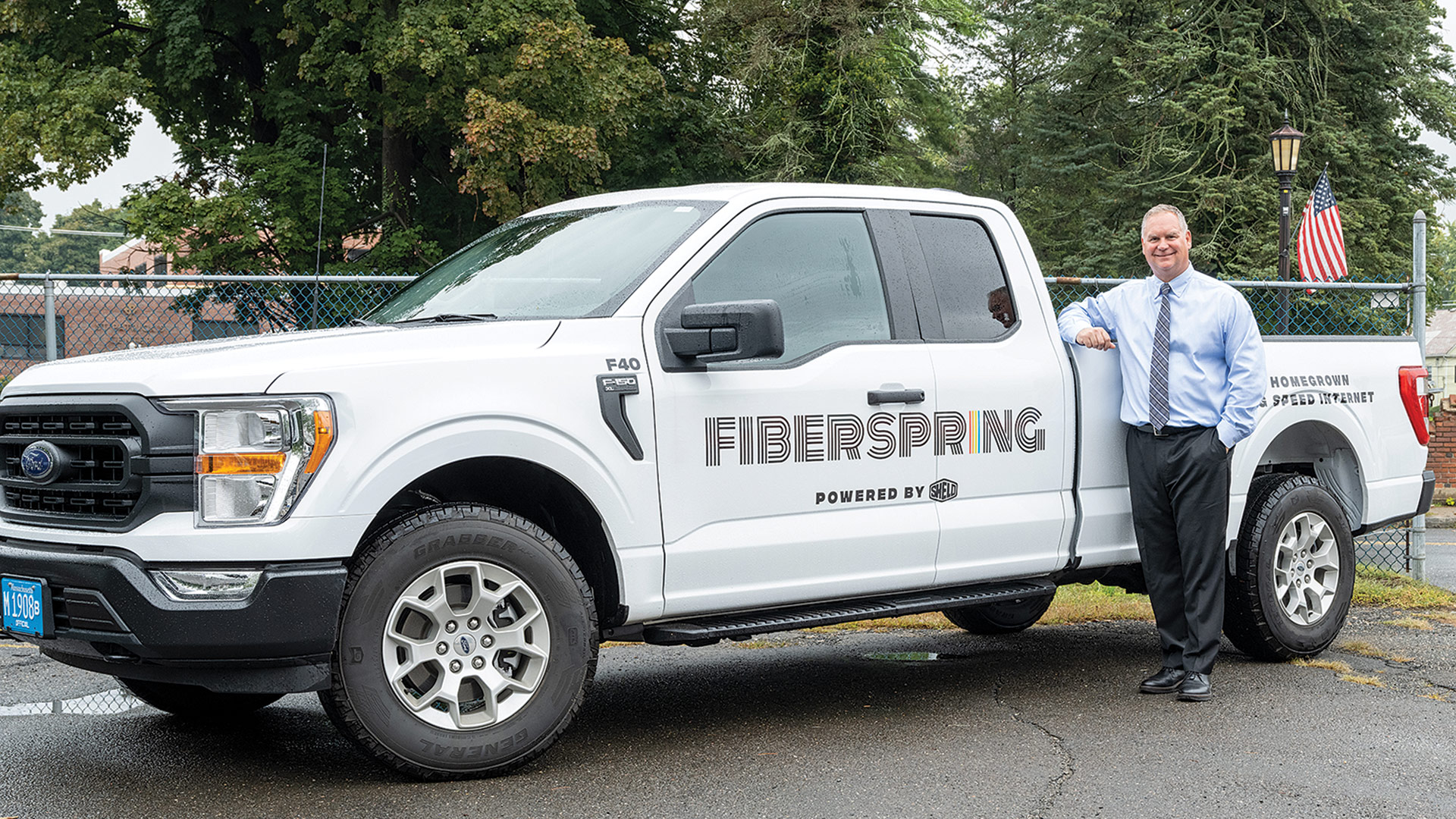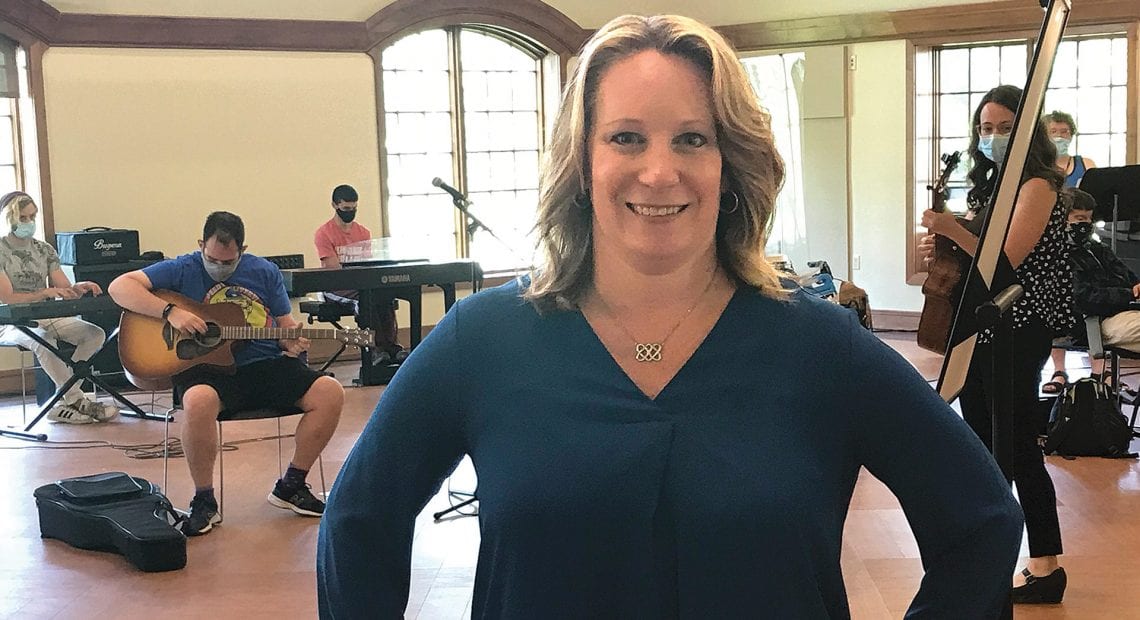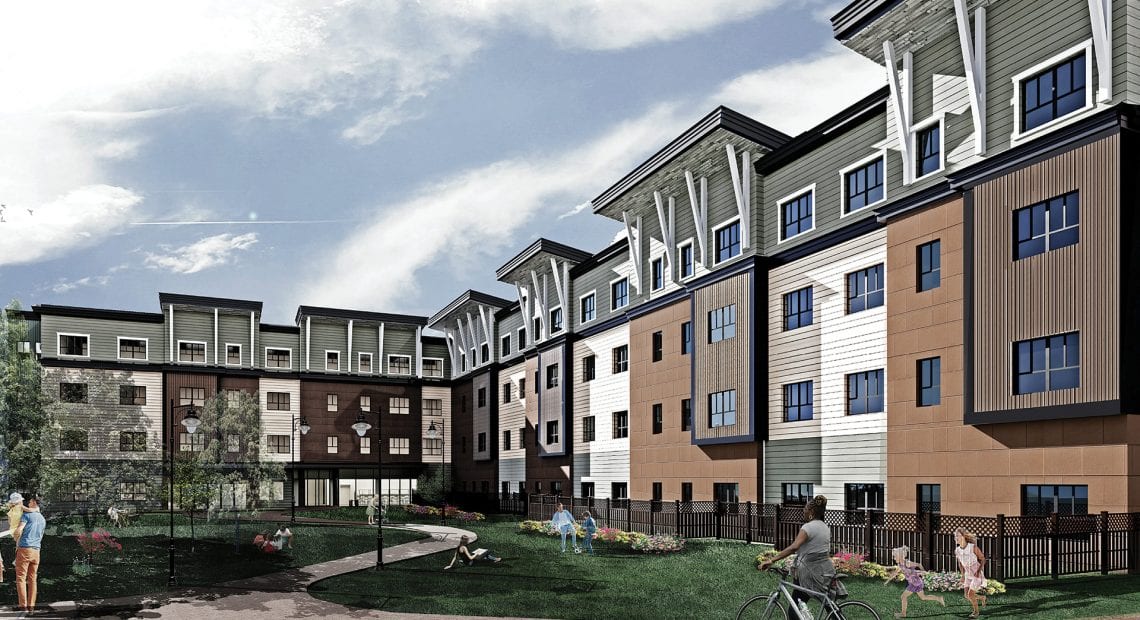Community Spotlight

An architect’s rendering of the housing project planned for the Woodlawn Shopping Plaza.
Rocco Falcone acknowledged that, when he and fellow partners Andy Yee and Peter Picknelly acquired the Woodlawn Shopping Plaza on Newton Street in South Hadley in 2016, they were making that sizable investment at a time when the world of retail was changing — and shrinking.
And they knew then that the plaza, dominated by a closed Big Y supermarket, might not look like it did years down the road — not that they didn’t try to find a strong retail anchor to fill the role that Big Y played.
“We knew there was going to be an unlikelihood that we’d be able to get another supermarket, although we tried like heck to — we talked to a number of chains, local, national, and international,” said Falcone, manager of South Hadley Plaza LLC, the entity created to acquire the property, and perhaps better known as president and CEO of the Rocky’s Ace Hardware chain. “When we bought it, we kept it in our minds that it might not be a supermarket — or even retail.”
And the Woodlawn Shopping Plaza will, indeed, take on a new look — and role that goes beyond shopping — with the announcement of plans to build 72 mixed-income apartments on a three-acre portion of the plaza where the Big Y once stood; a public hearing is slated on the proposal for June 26 at the South Hadley library.
Town Administrator Mike Sullivan, former mayor of Holyoke, sees the proposed housing project as an opportunity for the community, one that could change the face of an underperforming property (the plaza), perhaps spur new business development at the site and elsewhere, and even boost enrollment at the town’s schools, which have seen their numbers declining in recent years.
“We knew there was going to be an unlikelihood that we’d be able to get another supermarket, although we tried like heck to — we talked to a number of chains, local, national, and international. When we bought it, we kept it in our minds that it might not be a supermarket — or even retail.”
The announced plans for the plaza comprise one of a number of intriguing developments in South Hadley, a community of nearly 18,000 people that has always been an attractive place to live and has been working for decades to balance its strong neighborhoods with new business opportunities.
Others include progress toward an update of the community’s master plan; introduction of a new option for ultra-high-speed internet service, called FiberSonic, to town residents; efforts to work with neighboring Granby to bring more order to a hodgepodge of zoning on the Route 202 corridor; apparent progress in bringing the town’s long-underperforming municipal golf course, the Ledges, to self-sustainability; and even a new dog park on the Ledges property.
“Dog parks have become somewhat of a recreational amenity in many communities, including Northampton, Granby, and many other cities and towns,” said Sullivan. “It’s surprising how many people are really into their dogs; this is a quality-of-life issue, and at least this will put another 100 to 200 South Hadley residents onto property that they’re paying for. They don’t golf, but they have a dog.”
For the latest installment of its Community Spotlight series, BusinessWest looks at these various developments in South Hadley and how they are part of ongoing efforts to make the community a better place to work, live, and start a business.
Getting out of the Rough
Golf courses, especially municipal golf courses, usually don’t generate many headlines.
The Ledges has been a notable exception to that rule. Since it opened at the start of this century, it has been in the news often — and for all the wrong reasons. Indeed, conceived and built as Tiger Woods was rocketing to stardom and golf was booming as a sport and a business, the picturesque Ledges, with breathtaking views of the Holyoke Range, was projected to a be a strong revenue generator for the community.
Suffice it to say things haven’t worked out that way. In fact, the course has been a financial drain, racking up deficits of more than $1 million some years, and into six figures most years.
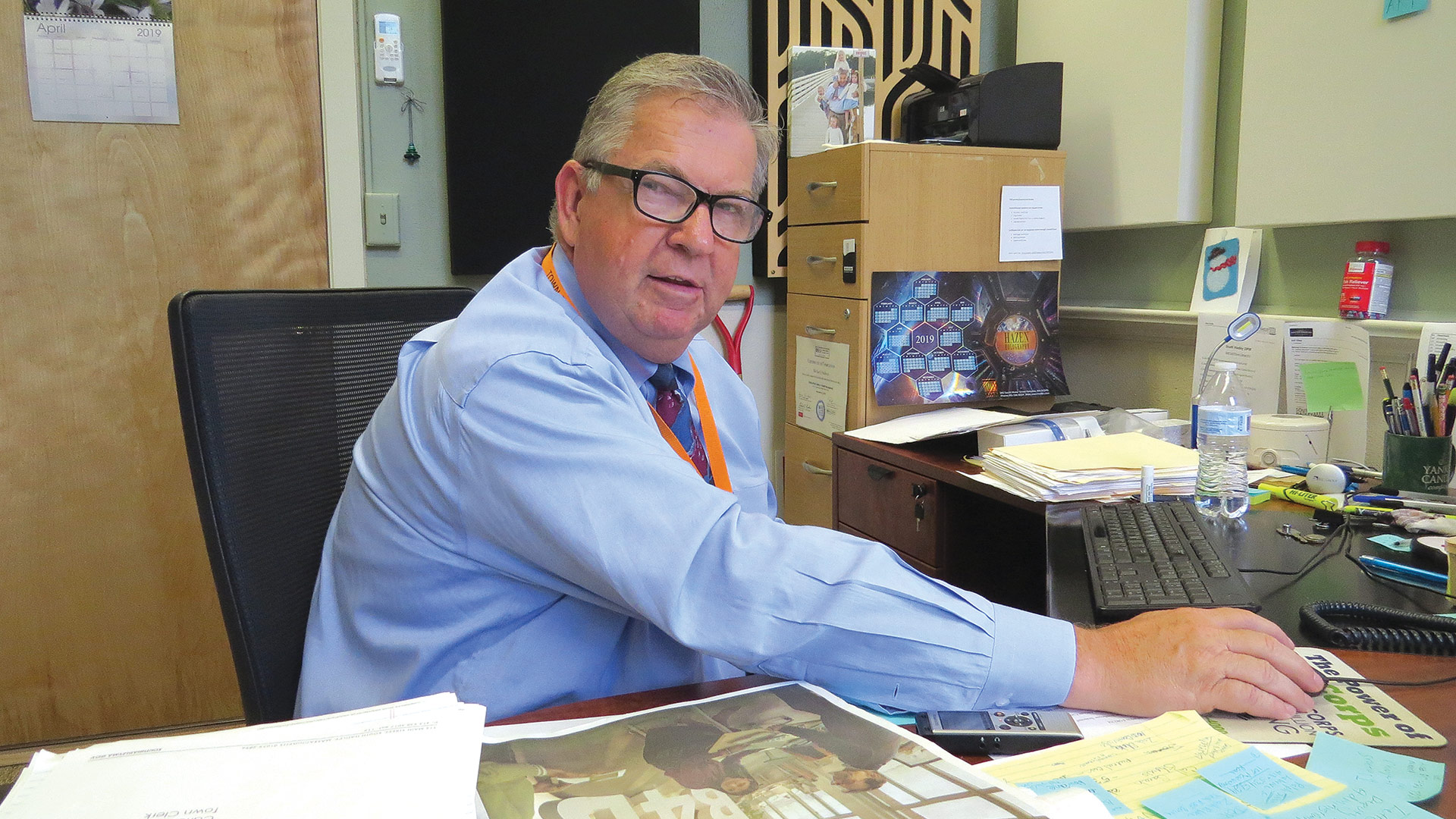
Town Administrator Mike Sullivan says new high-speed Internet service, called FiberSonic might spur more young professionals to move to South Hadley.
Sullivan, who inherited this problem, took the aggressive step of outsourcing not only maintenance of the course, but overall management of the facility, with the goal of turning things around and making the Ledges self-sustaining.
Mike Fontaine, the course’s general manager and an employee of Lakeland, Fla.-based International Golf Maintenance (IGM), which manages more than 30 courses across the country, is optimistic that some kind of corner has been turned at the Ledges. He noted that the shortfall was smaller last year (Sullivan pegged it at roughly $35,000) — despite unrelenting rains that made 2018 a difficult year for every golf course — and that, even with more rain early this year, the course is on track to improve on last year’s numbers and continue on an upward trajectory.
He said IGM’s efforts comprise work in progress, but added that a number of steps have been taken to improve the visitor experience and, thus, generate more revenue for the town. Work has been done to build a management team, place more emphasis on customer service, and give the 19th hole, an important revenue stream for all golf operations, a new look and feel. And even a new name.
“We gave the whole place a facelift, especially the restaurant,” he explained. “It was time for a fresh coat of paint, work behind the bar, new pictures of the golf course on the walls, moving the TVs, changing the name from Valley View restaurant to the Sunset Grille, and going with a whole new brand and marketing campaign.”
The new name highlights one of the course’s hallmarks — dramatic sunsets — and attempts to capitalize on that asset, said Fontaine, who said was inspired by what he saw in Key West, which is famous for its sunsets and people turning out to watch them.
He said the course has generally done well with visitation — 25,000 rounds last year — but needs a break from Mother Nature as well as a break from the negative publicity that hasn’t been good for business.
South Hadley at a Glance
Year Incorporated: 1775
Population: 17,791
Area: 18.4 square miles
County: Hampshire
Residential and commercial tax rate: $20.15 (Fire District 1); $20.55 (Fire District 2)
Median Household Income: $46,678
Median Family Income: $58,693
Type of government: Town meeting
Largest Employers: Mount Holyoke College; the Loomis Communities; Coveris Advanced Coatings; Big Y
* Latest information available
“We’re beating the numbers from last year, and we’re hitting our revenue goals despite losing three weekends in a row, including Mother’s Day weekend, due to rain — money we’ll never get back,” he said. “We’ll have a much better understanding of where we’re at when this year is over.”
While the picture seems to be improving at the Ledges, the picture is changing on Newton Street, especially at the Woodlawn Shopping Plaza.
While there is still significant retail there — the plaza is home to a Rocky’s, Dunkin’ Donuts, Dollar General, the Egg & I restaurant (a recent addition), the Parthenon restaurant, Mandarin Gourmet, and more — the former Big Y site was proving difficult to redevelop, said Falcone, noting that, after efforts to find a replacement supermarket were exhausted, the building was razed in 2018 with the goal of bringing more options to the fore, including residential.
The proposed 72-unit apartment complex will fill a need within the community for both affordable and market-rate housing, said Falcone, adding that this reuse is consistent with how many malls and shopping plazas are being repurposed at a time when stores are closing at an alarming rate and malls — and communities — are forced to be imaginative in a changing retail landscape.
“We looked at options to possibly subdivide the Big Y property, but we couldn’t get any junior anchors,” said Falcone, adding that the owners spent roughly the past year and half looking for smaller tenants, but to no avail.
“Retail is changing — people are getting away from retail and putting more focus on service and entertainment,” he said, adding that the town created an overlay district within the Newton Street area that allows for mixed-use development and residential space, which brings us to the plans currently on the table.
“We thought this would be a good option and a good opportunity,” said Falcone, adding that research revealed demand for such housing. “If you look at Village Commons, those apartments are always full, and my understanding is there’s a waiting list to get in there. So we think South Hadley is a great community for some additional housing.”
Sullivan agreed. “We’re a vibrant community for condominium development, and there’s considerable demand for them — we have condominiums on the riverfront selling for more than $400,000,” he noted. “But we think this proposed development balances things out; it provides another option for housing.”
The Gig-speed Economy
They’re called ‘fiberhoods.’
That’s the name the South Hadley Electric Light Department (SHELD) has given to areas, or neighborhoods, in the community that will be provided with FiberSonic, which will make gigabit-speed internet available to residential homes; the service is already available to South Hadley businesses.
SHELD is starting in the Ridge Road area — the service will be available there in July — and will proceed to the Old Lyman Road fiberhood in August, and the Hollywood Street area in September. By year’s end, 700 homes should be covered by the project, and the 32 identified fiberhoods will be added in phases over the next five years, said Sean Fitzgerald, SHELD’s general manager.
“Establishing fiber-optic internet service throughout the town will bring added convenience and, more importantly, will accommodate the ever-growing bandwidth need for South Hadley customers,” said Fitzgerald, who described FiberSonic as “home-grown, gig-speed Internet.”
This service should help make South Hadley a more attractive option for a growing number of professionals who essentially call the office home, even as they work for companies in Boston, New York, and Seattle, said Sullivan.
“When you can access a high-paying job in New York City, Boston, Montreal, or even Los Angeles, and you might have to only go to the home office once a month or once a week and the rest of the day work at home, your housing costs are lower and quality of life is higher in Western Mass.,” he explained. “We’re seeing more of this in South Hadley, and the new internet service will make this community even more attractive.”
As the overall pace of change accelerates, the town looks to anticipate what the future might bring — and be prepared for it — with an update to a master plan drafted roughly a decade ago.
That document, the town’s first master plan in more than three decades, included no less than 200 recommended actions, said Town Planner Richard Harris, noting that this represents an obviously unachievable number, although many have been implemented, especially in the realms of housing, recreation, and creation of growth districts.
He expects that the updated plan, to be completed by year’s end, will be more strategic in nature.
“While it will still be broad, because the nature of a master plan is broad, we’re expecting it to be more strategic in focus and more related to the current organizational structure and long-term needs of the community,” he told BusinessWest. “I wouldn’t expect as much focus on zoning and land use as the last plan, and instead more on how to capitalize on what we have done.”
There have been a number of community forums staged to solicit commentary and input about the plan and what it should include, as well as smaller, more informal sessions within neighborhoods called “meetings in a box,” said Harris, adding that a draft of a new plan should be ready for additional review by the fall and a final document in place by the end of the year.
Meanwhile, the town isn’t waiting for the new plan to address a long-term concern and probable hindrance to growth — the hodgepodge of zoning along the Route 202 corridor, roughly from Route 33 into Granby Town Commons.
“Both towns have the leftover remnants of a ’60s regional road,” he explained, noting that there are homes next to dinosaur-track stops next to other forms of business. “It’s not very well-organized; there’s a weird mix, and we think there is a real need for conformity.
“If we could get that conformity, there’s enough business traffic going into Belchertown, Ware, and, beyond that, Amherst — and we can harness that traffic,” he went on, adding there have been discussions with officials in Granby about zoning and also infrastructure and perhaps tying properties along that corridor into South Hadley’s sewer system, a development that would benefit both communities.
“We hope this will bring more investment to those commercial properties along 202 in South Hadley,” Harris explained. “That will result in more tax dollars — and it would be great to have more people to share the tax burden with.”
Bottom Line
Those last sentiments accurately reflect a goal, and an ongoing challenge, spanning decades: creating more opportunities to share the tax burden.
South Hadley has always been a great place to live — and now also play golf and walk your dog. Greater balance in the form of new businesses and better use of existing and potential commercial property has always been a goal and priority.
And between the proposed new housing project, faster internet service, and progress along the Route 202 corridor, the community is making more headway toward realizing that goal.
George O’Brien can be reached at [email protected]
